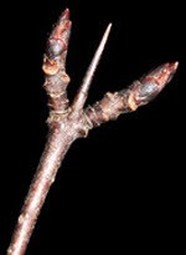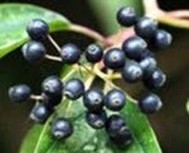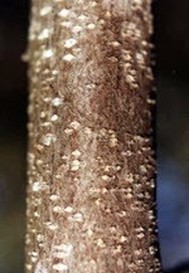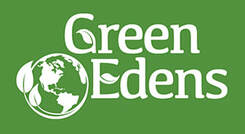INVASIVE PLANT MANAGEMENT
|
Invasive plants are any species not native to a particular ecosystem that cause environmental harm by elimination of many of the native species. This causes reduction of the natural biological diversity and degradation of habitat. The beauty and biological diversity associated with healthy natural and residential areas are being lost. Hundreds of invasive species occur in Illinois, and unfortunately, the list grows almost daily. The worst of the invasive plants is Buckthorn.
Buckthorn is native to Europe and was first brought to the Midwest in the mid-1800’s as a hedging material. Its invasive properties were discovered in the 1930’s, and Buckthorn has not been sold in nurseries since. Common Buckthorn is the most invasive of the species. Buckthorn produces thousands of berries. It is spread easily and rapidly by birds that feed on its fruit (berries). Birds carry the seeds for miles before excreting them in far-away locations where the seeds can grow into new buckthorn infestations.
Questions You May Have About Buckthorn: In what ways is Buckthorn harmful? Buckthorn competes with and eliminates native plants by taking away their nutrients, moisture and sunlight. It chokes out surrounding trees and make it impossible for any new growth to take root under its canopy of dense vegetation. Buckthorn degrades wildlife habitats and alters the natural food chain in and growth of an otherwise healthy forest. It disrupts the whole natural balance of the ecosystem. Buckthorn can host pests like Crown Rust Fungus and Soybean Aphids. Crown Rust can desecrate oat crops and a wide variety of other grasses. Soybean Aphids can have a devastating effect on the yield of soybean crops. Without buckthorn as the host, these pests could not survive to blight crops. Buckthorn contributes to erosion by overshadowing plants that grow on the forest floor, causing them to die and causing the soil to lose the integrity and structure created by such plants. Buckthorn lacks “natural controls” like insects or diseases that would curb its growth. A Buckthorn-infested forest is too dense to walk through, and the thorns of Common Buckthorn will leave you bloodied. Buckthorn attracts many species of birds (especially robins and cedar waxwings) that eat the berries and spread the seeds through their excrement. Not only are the birds attracted to the plentiful berries, but because the buckthorn berries have a diuretic and cathartic effect, the birds pass the seeds very quickly to the surrounding areas. This makes Buckthorn spread even more widely and rapidly, making it harder for us to control and contain. How difficult is it to remove Buckthorn? Very difficult, for several reasons: Any efforts to remove buckthorn just by cutting it down are usually unsuccessful. For one thing, buckthorn has an extensive fibrous root system, which allows it to survive dormant in the soil for long periods of time. Also, if you cut down the Buckthorn but choose not to treat the stumps with poison, they will re-sprout vigorously. Within 3-4 years a stump sprout will grow large enough to flower and produce fruits, which birds eat and then deposit on other areas, causing Buckthorn to grow in those areas. |
Learn more about:
Images of Buckthorn:
|
Even the seeds themselves are very tough. Buckthorn seeds are viable for up to 5-7 years in the soil. You can kill a patch of buckthorn, but if you don’t scour the area for seeds and monitor the area for new growth, the seeds can grow into new Buckthorn just when you think you’ve killed it off and won the battle.
What should I do if Buckthorn has invaded my property?
Have it removed or remove it yourself.
If the Buckthorn plants are smaller than a pencil, you can simply pull it from the ground. Buckthorn at this size, removes easily, especially after a rain.
If the diameter of the trunk is larger than a pencil, you should use the “cut-stump method”. Cut the Buckthorn off leaving around 3-4 inches of the trunk exposed. Paint the stump and surrounding bark with a mixture of Garlon4 and Impel Red. The poison is carried down into the root system systemically and therefore will not affect anything else around its vicinity. Pulling Buckthorn that is this large is not a good option, because many of the fibrous roots in the ground will remain intact. The roots will continue to grow and re-sprout into Buckthorn plants in a very short amount of time. By painting the poison onto the stump, you allow the poison to spread down into the root system and kill the roots.
*Always read the chemical labels and follow the instructions. Chemicals like Garlon4 can become volatile in temperatures above 85 degrees Fahrenheit and can impose serious health risks if inhaled.
How long does removal usually take and how much does it cost.
We typically charge $65.00 per man-hour, plus chemical and equipment fees (i.e. bobcat, wood chipper, etc.)
Removing Buckthorn is an arduous process that is only effective when done methodically. Each Buckthorn tree that is cut needs to be dragged over to a wood chipper, fed through the machine, and have its stump treated with a very potent herbicide that must be applied with precision.
Because Buckthorn varies in size and density, it is impossible to give an average amount of time (i.e. how long it would take 2 men to clear one acre of buckthorn and how much buckthorn is being cleared). Hence the reason most companies work “by the hour”.
What should I do once the Buckthorn is removed?
The best way to keep Buckthorn from coming back is to monitor new saplings and removing them right away and replant trees and shrubbery that help strengthen the surrounding ecosystem. We typically replant the area immediately after we remove the buckthorn. As tough and aggressive as Buckthorn is, it can’t grow as easily around well-developed plants, where it has to compete for nutrients and sunlight.
We recycle the shredded Buckthorn and use it around the base of each new planting to help keep the weeds down and retain moisture. The mulch snuffs out dormant seeds in the soil so that they don’t produce new growth. We have found this method of Buckthorn removal to be the most resourceful and cost-effective. The shredded Buckthorn serves as a regenerative purpose, and the customer does not have to pay additional fees to have the Buckthorn hauled off-site for disposal. Also, hauling the Buckthorn off-site for disposal without being chipped only contributes to the spread of Buckthorn, whereas killing it, chipping it, and reusing it on-site can turn blight into a blessing for the ecosystem.
Is there a way I can prevent Buckthorn from growing in the first place?
There is nothing you can do to prevent Buckthorn other than remove it or have it removed as soon as you see it. That is why it’s considered an invasive species. The best way to prevent Buckthorn is simply to be able to identify it and remove it or have it removed.
Our philosophy is to place the right plants in the right place using quality plant material appropriate to the Midwest Region. We actively work and consult with our customers to help them achieve long term planting success. We at Green Eden’s Horticultural Services are experts in identifying invasive species such as buckthorn, and at removing them in a manner that is not harmful to the environment.
How we will end your Buckthorn Problem
We remove the Buckthorn, prevent it from coming back, offer a maintenance program, mulch it on-site, and plant healthy shrubs and or trees in place of the Buckthorn – all at the same time. The new shrubs make your property look good again and it is beneficial to the environment.
What should I do if Buckthorn has invaded my property?
Have it removed or remove it yourself.
If the Buckthorn plants are smaller than a pencil, you can simply pull it from the ground. Buckthorn at this size, removes easily, especially after a rain.
If the diameter of the trunk is larger than a pencil, you should use the “cut-stump method”. Cut the Buckthorn off leaving around 3-4 inches of the trunk exposed. Paint the stump and surrounding bark with a mixture of Garlon4 and Impel Red. The poison is carried down into the root system systemically and therefore will not affect anything else around its vicinity. Pulling Buckthorn that is this large is not a good option, because many of the fibrous roots in the ground will remain intact. The roots will continue to grow and re-sprout into Buckthorn plants in a very short amount of time. By painting the poison onto the stump, you allow the poison to spread down into the root system and kill the roots.
*Always read the chemical labels and follow the instructions. Chemicals like Garlon4 can become volatile in temperatures above 85 degrees Fahrenheit and can impose serious health risks if inhaled.
How long does removal usually take and how much does it cost.
We typically charge $65.00 per man-hour, plus chemical and equipment fees (i.e. bobcat, wood chipper, etc.)
Removing Buckthorn is an arduous process that is only effective when done methodically. Each Buckthorn tree that is cut needs to be dragged over to a wood chipper, fed through the machine, and have its stump treated with a very potent herbicide that must be applied with precision.
Because Buckthorn varies in size and density, it is impossible to give an average amount of time (i.e. how long it would take 2 men to clear one acre of buckthorn and how much buckthorn is being cleared). Hence the reason most companies work “by the hour”.
What should I do once the Buckthorn is removed?
The best way to keep Buckthorn from coming back is to monitor new saplings and removing them right away and replant trees and shrubbery that help strengthen the surrounding ecosystem. We typically replant the area immediately after we remove the buckthorn. As tough and aggressive as Buckthorn is, it can’t grow as easily around well-developed plants, where it has to compete for nutrients and sunlight.
We recycle the shredded Buckthorn and use it around the base of each new planting to help keep the weeds down and retain moisture. The mulch snuffs out dormant seeds in the soil so that they don’t produce new growth. We have found this method of Buckthorn removal to be the most resourceful and cost-effective. The shredded Buckthorn serves as a regenerative purpose, and the customer does not have to pay additional fees to have the Buckthorn hauled off-site for disposal. Also, hauling the Buckthorn off-site for disposal without being chipped only contributes to the spread of Buckthorn, whereas killing it, chipping it, and reusing it on-site can turn blight into a blessing for the ecosystem.
Is there a way I can prevent Buckthorn from growing in the first place?
There is nothing you can do to prevent Buckthorn other than remove it or have it removed as soon as you see it. That is why it’s considered an invasive species. The best way to prevent Buckthorn is simply to be able to identify it and remove it or have it removed.
Our philosophy is to place the right plants in the right place using quality plant material appropriate to the Midwest Region. We actively work and consult with our customers to help them achieve long term planting success. We at Green Eden’s Horticultural Services are experts in identifying invasive species such as buckthorn, and at removing them in a manner that is not harmful to the environment.
How we will end your Buckthorn Problem
We remove the Buckthorn, prevent it from coming back, offer a maintenance program, mulch it on-site, and plant healthy shrubs and or trees in place of the Buckthorn – all at the same time. The new shrubs make your property look good again and it is beneficial to the environment.




